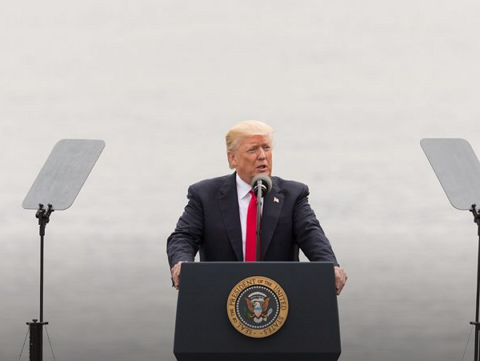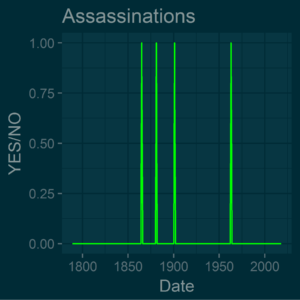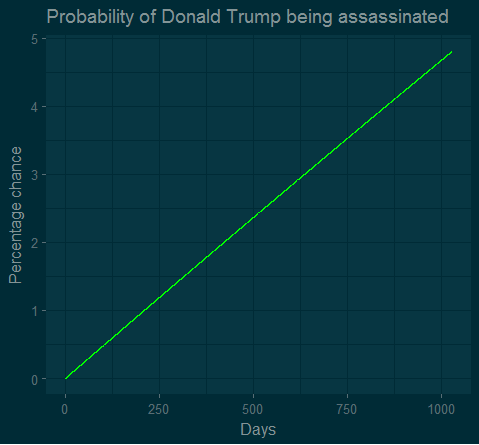Will Donald Trump die for his country?
 Presidential assassinations are rare events. Since 1789, when George Washington became president, only four US presidents have been assassinated. Abraham Lincoln in 1865, James Garfield in 1881, William McKinley in 1901 and John F Kennedy in 1963. This doesn’t change the fact that from an occupational point of view, being US President is a dangerous job – there have been 44 different men who have served in this office, meaning that over 9% of them have been assassinated. Admittedly the job of US President is safer than being a British solider in World War War I, where the death rate was 11.5%, but far more dangerous than being a US serviceman in Vietnam between 1964 and 1975, with a death rate of less than 1%. So we shouldn’t condemn Clinton, Bush Junior and Trump for skipping the draft, because their willingness to go to the White House shows that they were ready and willing to lay down their lives for their country.
Presidential assassinations are rare events. Since 1789, when George Washington became president, only four US presidents have been assassinated. Abraham Lincoln in 1865, James Garfield in 1881, William McKinley in 1901 and John F Kennedy in 1963. This doesn’t change the fact that from an occupational point of view, being US President is a dangerous job – there have been 44 different men who have served in this office, meaning that over 9% of them have been assassinated. Admittedly the job of US President is safer than being a British solider in World War War I, where the death rate was 11.5%, but far more dangerous than being a US serviceman in Vietnam between 1964 and 1975, with a death rate of less than 1%. So we shouldn’t condemn Clinton, Bush Junior and Trump for skipping the draft, because their willingness to go to the White House shows that they were ready and willing to lay down their lives for their country.
We then have to ask whether or not the four presidential assassinations are telling us anything about future likelihood. One could argue that three of the four assassinations happened over a short period of time – between 1865 and 1901 – and they won’t happen again. These three assassinations involved handguns. Maybe those charged with protecting presidents hadn’t fully appreciated the dangers posed by high quality weapons, which were easy to conceal. After McKinley’s assassination, there were no more assassinations with handguns, and it took a sniper’s rifle in 1963 to kill John F. Kennedy. Yet in 1975 there were two assassination attempts on Gerald Ford, both with handguns, which could easily have succeeded. And in 1981 Ronald Reagan was wounded by a bullet fired from a revolver.
If we want to use the past four assassinations to assess the likelihood of futures ones we have to assume that the chances of assassination are the same, across the whole 229 year period. Perhaps we could say that the protection given to presidents is balanced by increasing desires and opportunities to assassinate. Maybe George Washington, as the first US President, had very little protection, but very few people had an inclination to kill him. As protection increased, presumably after the assassination of Abraham Lincoln, so did the population of the US, as well as the number of guns in circulation. In other words, there remained one president, but an increasing pool of people who might want to attack him.
There is also the question of independence. I am assuming that all four assassinations were independent events, not influenced by one another. James Garfield was assassinated only 16 years after Abraham Lincoln, so the memory of the event was still fresh in the national consciousness. Under these circumstances, one might argue that one should treat the three Nineteenth Century assassinations as a single event. In which case we can regard there as only being two independent assassinations since 1789.
Assuming that each assassination was an independent event, and that the probability of an assassination has been constant since George Washington became president, we can say that each year there is a 1.75% chance of the President being assassinated. We can see the four assassinations in one graph:

We can now make a crude estimate of what the chances of Donald Trump being assassinated are, by end of his term on January 20, 2021. Remember, I am talking about assassination. A president doesn’t have to be assassinated to die in office, and since 1789 there have been four who have died of natural causes. Donald Trump, as a 71 year-old male, has a 2.5% chance of dying over the course of a year. OK, it’s probably lower than that, because currently he’s in good physical shape and he also has access to the best healthcare in the world.
In terms of assassination, we have to consider when the next event will occur. Assuming America continues to have presidents, it is unlikely that that there won’t be another assassination. Even if presidents and other leaders cut themselves off from the unwashed masses, they can still be assassinated. For example by security guards, like Indira Gandhi, or by supposed colleagues, like Julius Caesar.
Now for some mathematics. If we want to calculate a crude probability of a presidential assassination, within a particular time period, we can use the cumulative density function of the exponential distribution:

The letter e is log natural (2.718), λ is the mean number of assassinations per year, and t is time. There are 0.0175 assassinations per year (4 divided by 229) and let’s take 20 years as time. This means that the probability of a president being assassinated sometime between now and 2038 is 0.2949, or 29.49%. However if you want a 50% chance, then you would have to go out 39.68 years. In other words, we can say that there is a 50% change that a US president will be assassinated in the next 40 years. Below is the probability graph of the next 100 years, with the red line pinpointing the 50% chance at 40 years. The green line hits 80% after 100 years, indicating an 80% chance of an assassination between now and 2118.

What about Trump? Today is March 29 2018. On April 30 1789, 83,608 days ago, George Washington became US president. So right now, the chances of a president getting assassinated in a one-day period are 1 in 20,902. Moving forward, there are 1028 days left before Trump’s term of office ends. We can then create a new graph, which zeros in on the remainder of his term:

Looking at these 1028 days, on Thursday March 29 2018, we see that the chance of him being assassinated by the end of 2018 is 1.29%. Looking forward to the end of his first term, on January 20 2021, and it’s 4.78%. A chance that’s small but not insignificant.
One final point. These probabilities only hold for the day you calculate them If it is January 1 2019, and Trump is still alive and tweeting, you’d have to do the calculations all over again. You would find that the chances of an assassination between that date and the end of the first term would be only 3.51%.